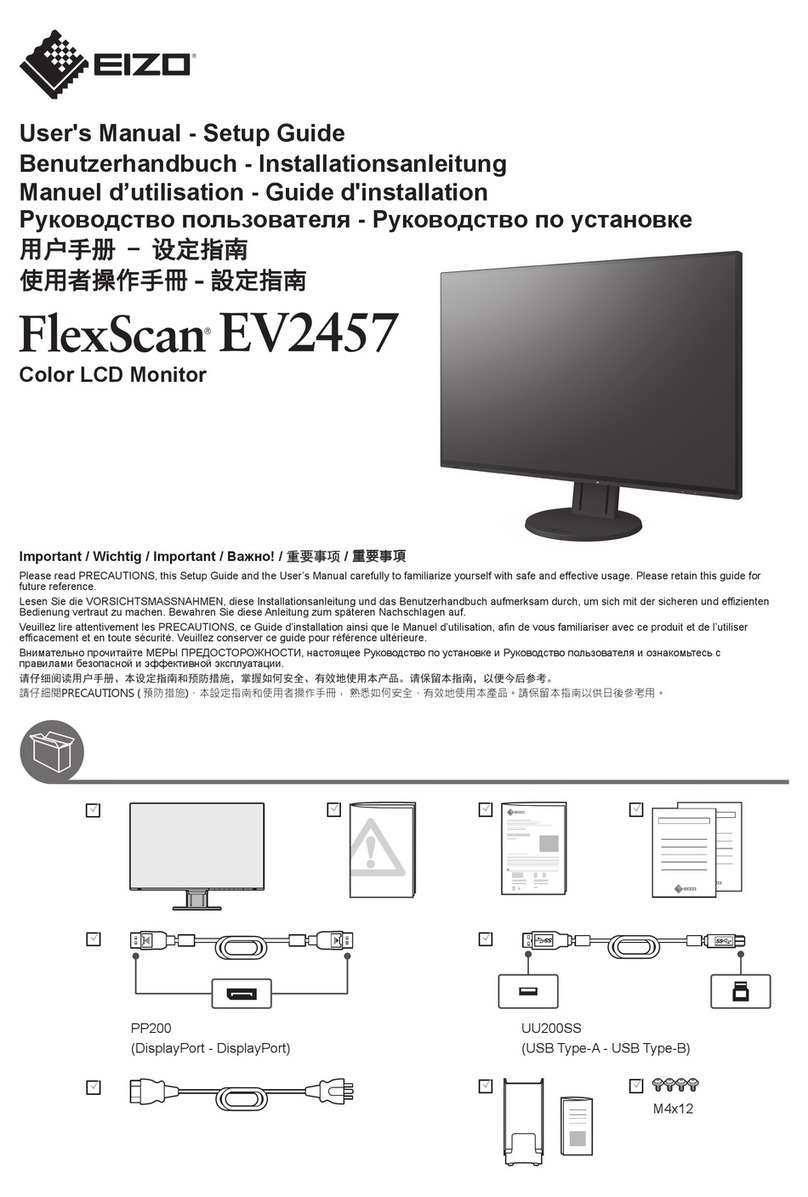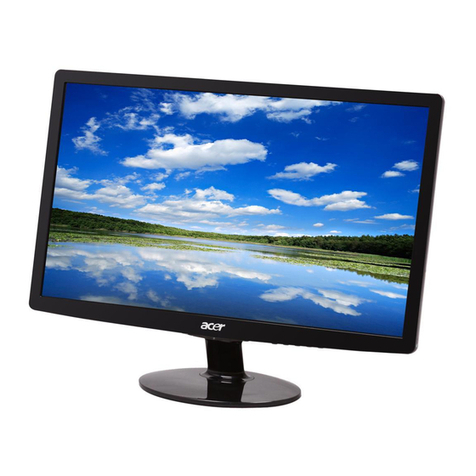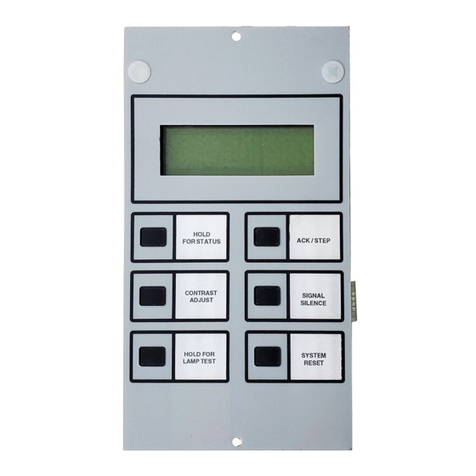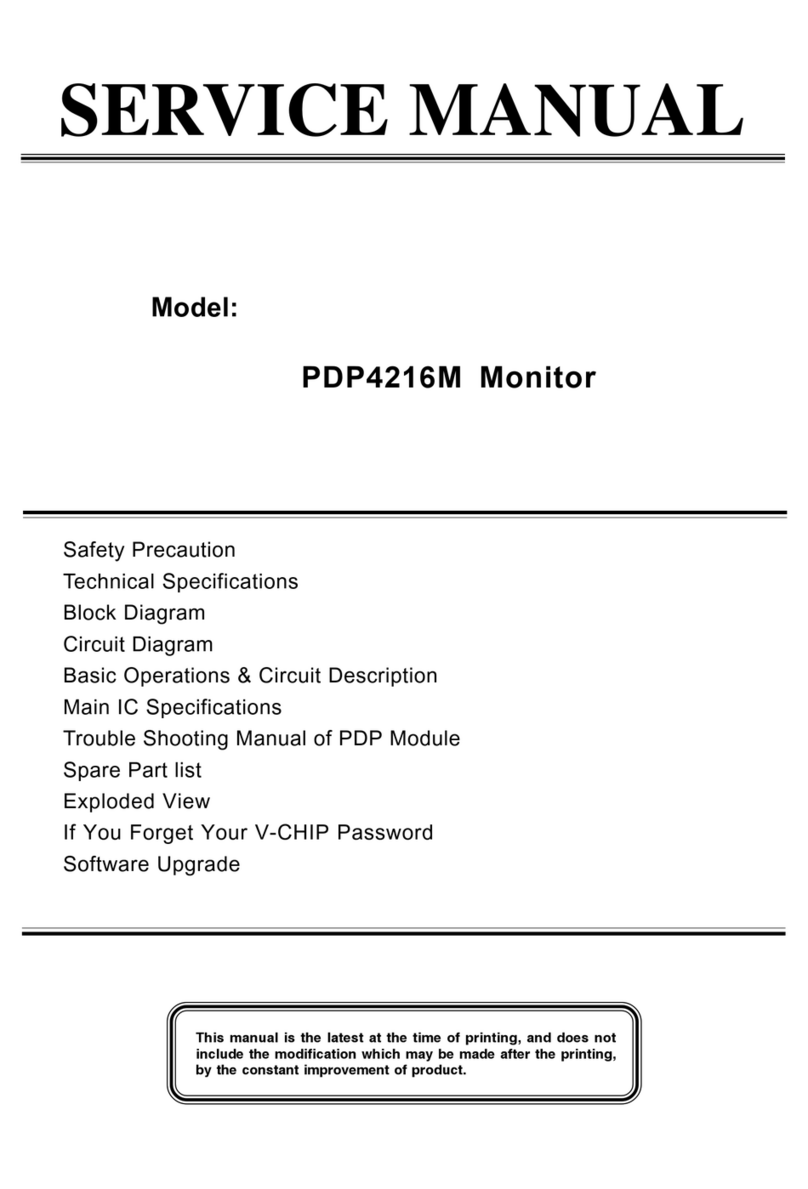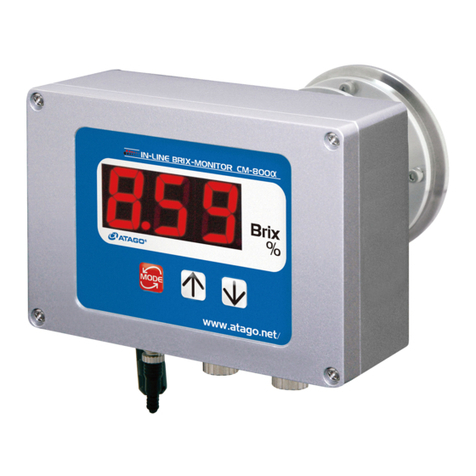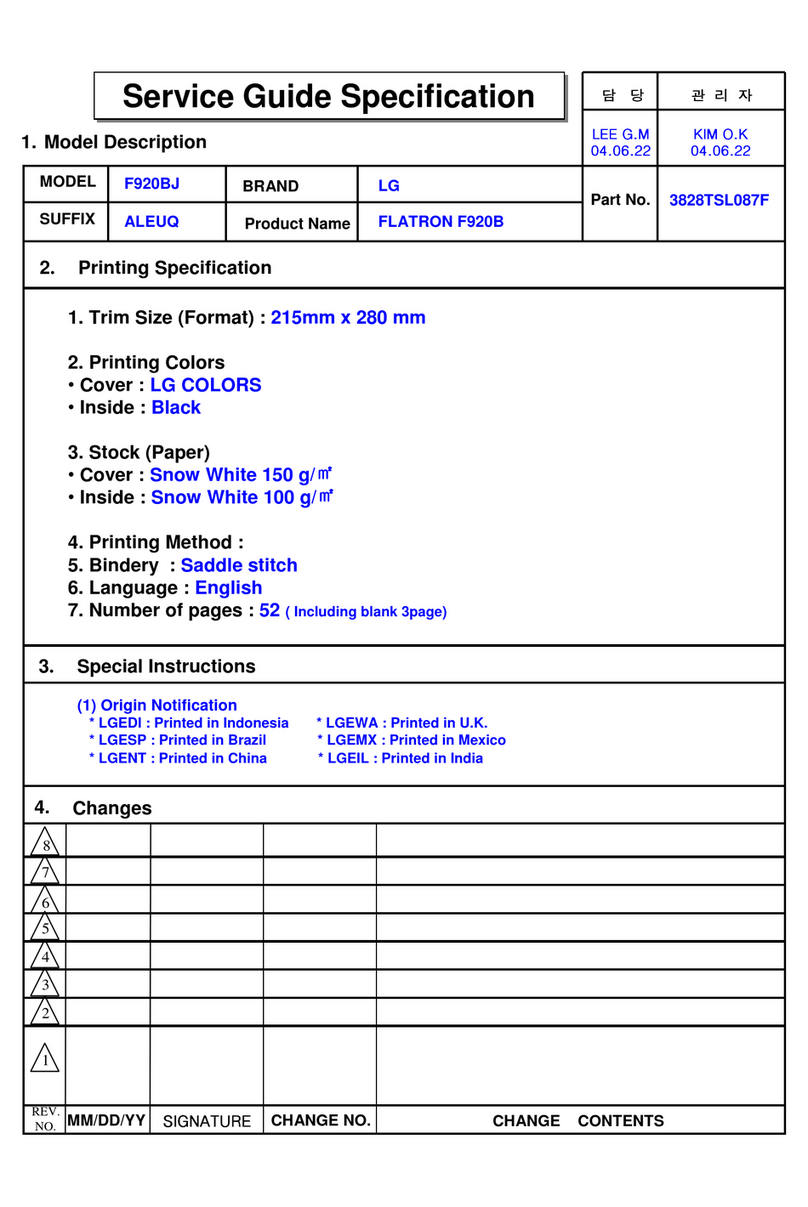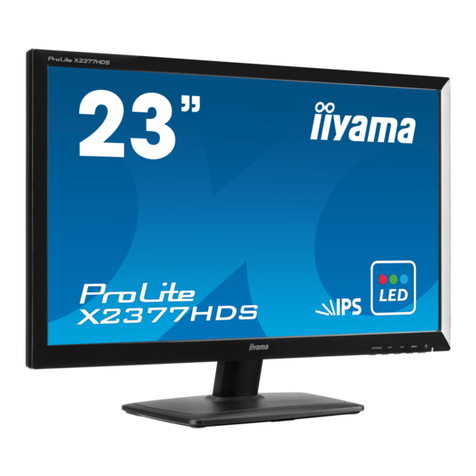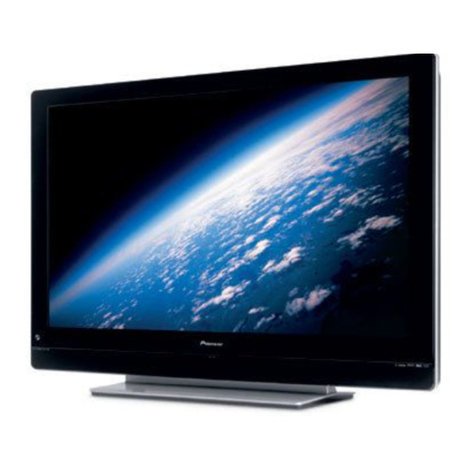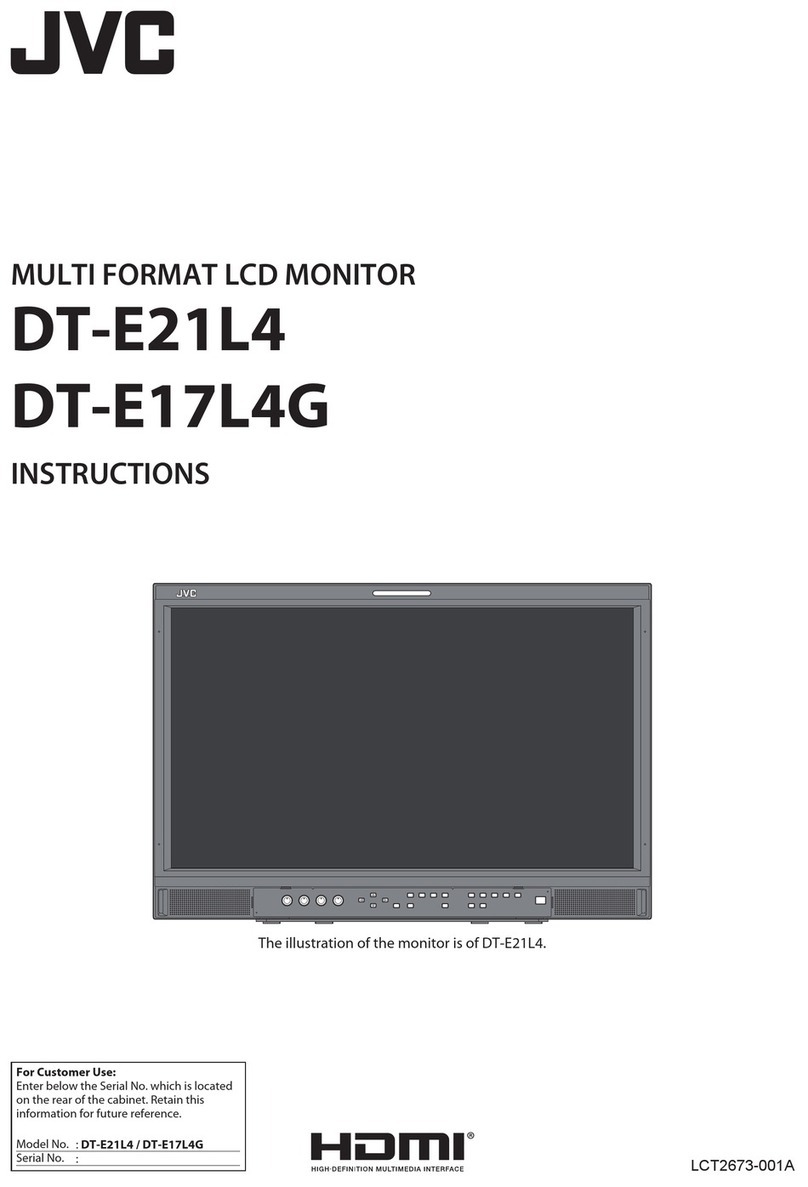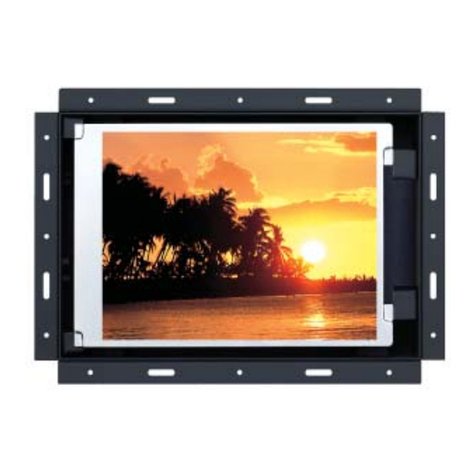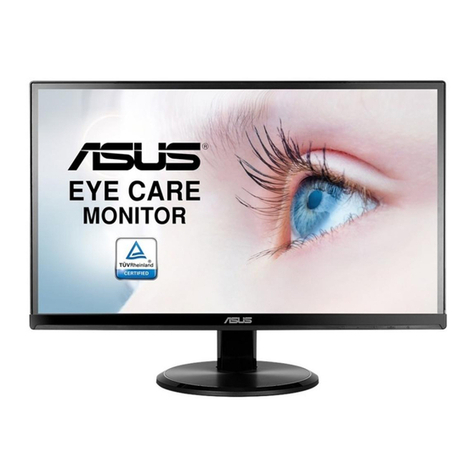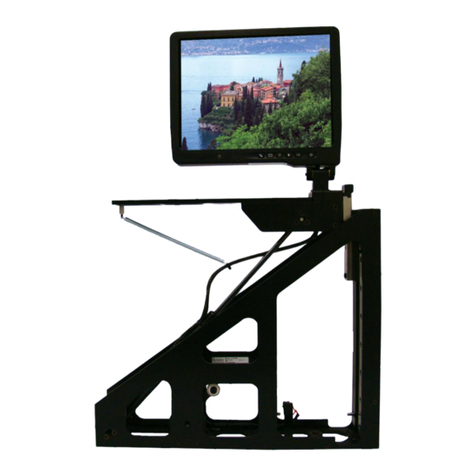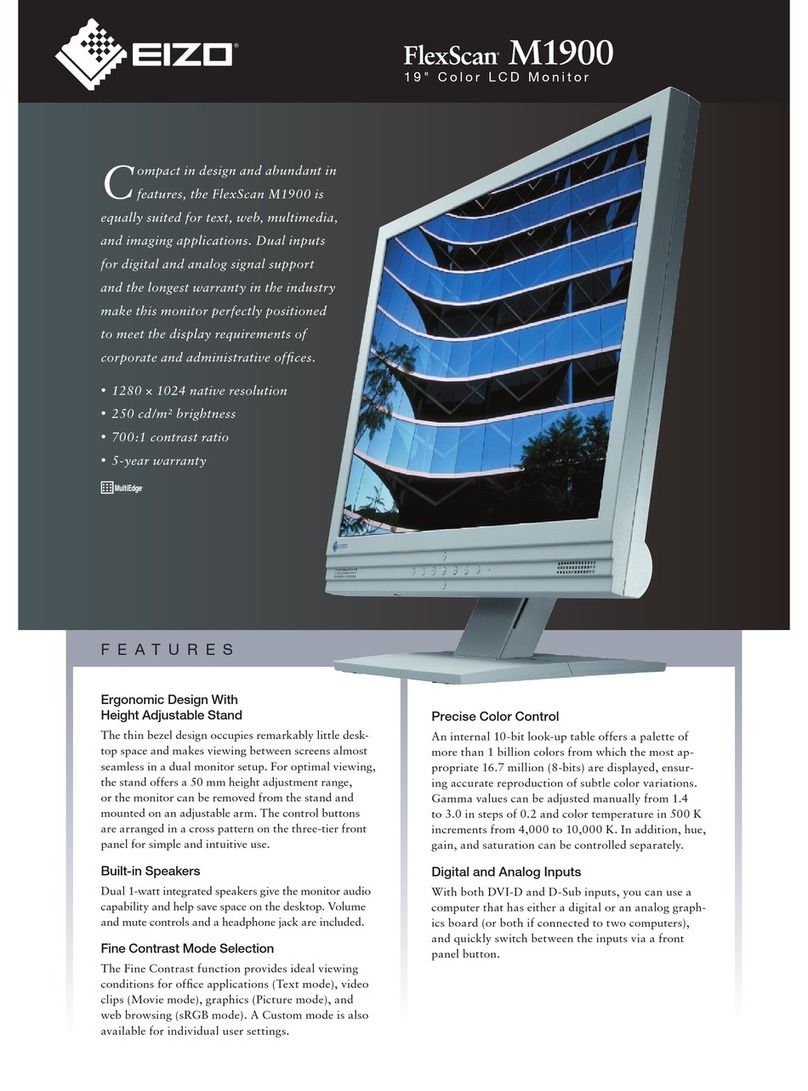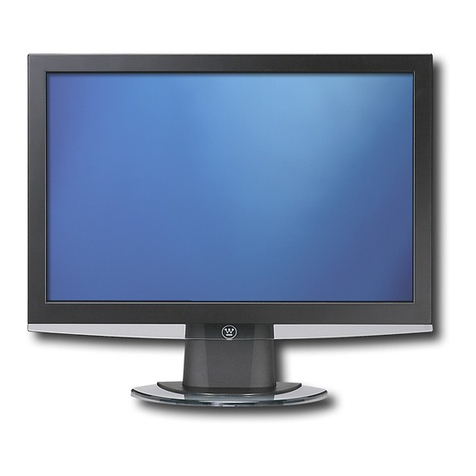ECM afm1000 User manual

AFM1000 / AFM1500
Air-Fuel Ratio Combustion Monitor
Extended Range (6 ~ 20 AFR) Version
Instruction Manual
02/06 Part Number 1000A-6b
™
™

©COPYRIGHT 2004 by ECM: ENGINE CONTROL AND MONITORING.
All Rights Reserved.
No part of this manual may be photocopied or reproduced in any form without prior written
consent from ECM: ENGINE CONTROL AND MONITORING.
Information and specifications subject to change without notice.
AFM1000 and AFM1500 are trademarks of ECM: Engine Control and Monitoring.
Printed in the United States of America.

Table of Contents
Introduction 1
The Air-Fuel Ratio Combustion Monitor (AFM) 1
AFM1000/AFM1500 Components List 1
Important Operation Notes 3
How to Use 4
Hooking-up the AFM 4
Power 5
Warm-up 5
Analog Output 5
SMB Interface (Serial Measurement Bus, AFM1500 Only) 6
Calibration 8
Fuel Type Compensation 9
Pressure Compensation 9
Specifications and Limits 11
Measurement Range and Accuracy 11
Exhaust Operating Limits 11
Sensor Installation 11
Output Specifications and Limits 11
General Information 12
Troubleshooting 13
Safety Warnings 14
Warranty and Disclaimers 15
i

Supplementary Information 17
ii

Introduction
The Air-Fuel Ratio Combustion Monitor (AFM1000/AFM1500)
The ECM Air-Fuel Ratio Combustion Monitor (AFM) was designed for the professional
calibration of fuel-injection or carburetor systems. Using a state-of-the-art, wide-range
UEGO (Universal Exhaust Gas Oxygen) sensor, the AFM provides unmatched measurement
range, accuracy, and speed-of-response in a compact, lightweight package. Suitable for
dynamometer or in-vehicle applications, the AFM is an essential tool for any engine
development program.
AFM features:
•Measurement range of 6 to 20 AFR (gasoline1)
•Easy calibration in air
•0 to 5 volt linearized output for use with data acquisition or engine control
systems
•SMB (Serial Measurement Bus) Interface on AFM1500
•11 to 28 VDC operation2
AFM1000/AFM1500 Components List
The following items are included with an AFM1000 Kit:
Item No. Description Part Number
1. Control Module (AFM1000) 1000A-1b
2. UEGO Sensor 1000A-2
3. Wiring Harness, 20’ or 1000A-3a3
Wiring Harness, 10’ or 1000A-3b3
Wiring Harness, 3’ 1000A-3c3
4. Calibration Screwdriver 2400E-35
5. Sensor Mounting Boss and Plug (M18X1.5mm) 1000A-5
6. Instruction Manual 1000A-6b
1Assumes fuel H:C ratio of 1.85. For other fuels see the “Fuel Type Compensation” section.
2An AC/DC Power Supply (P/N 1000A-7) is available.
3ECM offers custom harness solutions. Contact ECM for more information.
1

The following items are included with an AFM1500 Kit:
Item No. Description Part Number
1. Control Module (AFM1500) 1500A-1b
2. UEGO Sensor 1001A-2
3. Wiring Harness, 20’ or 1002A-3a1
Wiring Harness, 10’ or 1002A-3b1
Wiring Harness, 3’ 1002A-3c1
4. SMB/PC Cable, 6' (AFM1500) 1500A-16
5. SMB/PWR Cable, 1' (AFM1500) 1500A-17
6. Calibration Screwdriver 2400E-35
7. Sensor Mounting Boss and Plug (M18X1.5mm) 1000A-5
8. Instruction Manual 1000A-6b
1ECM offers custom harness solutions. Contact ECM for more information.
2

Important Operation Notes
1. Before installing the UEGO sensor, apply a small amount of non-lead containing
antiseize compound to its threads. Do not get the compound on the sensor’s tip.
2. Do not operate an engine for more than three minutes with the UEGO sensor in the
exhaust and the control module’s power off. If the sensor is off in a running engine
for a longer period, soot and water will condense in the sensor and may reduce its
sensitivity.
3. Do not use the UEGO sensor in exhaust systems in which water is sprayed into the
exhaust. Water striking the sensor may cause permanent sensor damage.
4. Do not put the UEGO sensor in a heavily sooting or oil-burning engine.
5. Use of the UEGO sensor with leaded fuels over time may reduce the sensitivity of the
sensor.
6. Do not use the UEGO sensor in a location where the temperature is greater than 950 deg.
C (1742 deg. F) or if the pressure is not between 0.8 to 1.3 atm (23.9 to 38.9 inches Hg,
81 to 132 kPa).
7. Route and cable-tie the wiring harness away from hot or moving objects and ignition
wires.
8. Do not remove or attach the UEGO sensor from the instrument harness when the control
module power is on.
9. Do not drop the UEGO sensor onto a hard surface.
10. Do not expose the UEGO sensor to flammable substances.
11. Do not attempt to wash the UEGO sensor with any solvent or compressed air.
3

How to Use
Hooking-up the AFM
Location of the UEGO Sensor
The UEGO sensor should be located from 12" to 48” from the exhaust valve(s) of the engine.
A location further from the engine may be used as long as it is at least ten times the exhaust
pipe diameter upstream of the end of the exhaust system. For example, with a 2½" diameter
exhaust pipe, the sensor should be at least 25" upstream of the end of the exhaust. The
problem with locations less than ten diameters upstream is that reversion air may be trapped
in the exhaust giving leaner than actual readings. This especially occurs at low exhaust
flowrates (i.e. idle). Locating the UEGO sensor far from the engine exposes the sensor to
more liquid water during both start-up and normal operation and is not recommended.
When choosing a UEGO sensor location, take into consideration engine movement, ground
clearance, and wire harness routing.
Mount the UEGO sensor in a location where the sensor’s wires are pointing upward (9
o’clock to 3 o’clock). Do not mount the sensor where liquid inside the exhaust may
collect in the sensor or its threads.
Install the UEGO sensor by lightly coating its threads with a non-lead containing antiseize
compound and tighten it to 30 ±3 ft-lbf (40 ±4 Nm). Attach the sensor to the wiring harness
and route the harness to the control module. Use cable ties to keep the harness away from
hot or moving objects and ignition wires.
Do not modify the wiring harness. Replace the wiring harness if it becomes damaged.
Installation of the Sensor Mounting Boss
The UEGO sensor is mounted in the engine’s exhaust by threading it into a M18X1.5mm
boss that is cast, welded, or brazed onto the engine's exhaust pipe. This thread size is
identical to that of most exhaust oxygen sensors (O2sensors) used in production automobiles
with 3-way exhaust catalysts.
The sensor boss provided has a M18X1.5mm thread. To mount the boss, first drill a ¾"
diameter hole in the desired location. Clean the area around the hole with a wire-brush and
clamp the boss over the hole. Weld or braze the boss to the exhaust pipe. After the boss is
attached to the exhaust, tap the treads to clean them and file the top of the boss to provide a
flat surface for sealing.
When the UEGO sensor is not being used, use the supplied plug (with some anti-seize) to
plug the hole. Do not use the UEGO sensor to plug the hole during engine operation when
the control module is not powered-up.
4

Power
The AFM requires clean DC power of 11 to 28V at 1.4A (steady-state). During sensor
warm-up, the requirements are approximately 5A for a period of up to 1 minute. A good car
or motorcycle 12V battery can meet these specifications. An AC/DC power supply is
available (P/N 1000A-7). The supplied wiring harness must be connected directly to the
power source. Do not modify the wiring harness without first contacting ECM.
Warm-up
After powering-up the AFM, it will take approximately 30 seconds for the control module to
bring the UEGO sensor to its operating temperature. It is okay to have the engine running
during this period. In fact it is recommended that a cold engine be started for a short period
(i.e. one minute) before the AFM is powered-up. The reason for this is to allow any
condensed water to be cleared from the exhaust system. Any liquid can thermally shock the
UEGO sensor.
For applications where the sensor is mounted in a tailpipe probe, it is especially important to
make sure that all condensed water is out of the tailpipe before the tailpipe probe is inserted
into the exhaust.
Analog Output
The AFM has a 0V to 5V linearized output suitable for input into a data acquisition or engine
control system. The analog output is available from the female BNC connector on the wiring
harness. For the AFM1000 only, the shell of the connector is signal ground and it is
electrically connected to the power source ground.
The measurement range for gasoline is 6.0 to 20.0 AFR. The relationship between the
analog output (Vout) and the AFR for gasoline1is:
AFR = 2.8 x Vout + 6.0 (gasoline only) [Equation 1]
For example, if Vout is 1.0 V then the AFR is 8.8:1.
When the AFM is first turned on, the output passes through a sequence of three voltages.
Each voltage is held for five seconds. For the AFM1000, these three voltages are 0.0V,
3.06V and 5.0V, and correspond to 6.0, 14.56 and 20.0 AFR respectively. For the
AFM1500, the three voltages are 0.5V, 3.06V and 4.5V, which correspond to 7.4, 14.56, and
18.6 AFR respectively. The purpose of this sequence is to verify correct electrical
connection and signal conversion with the AFM and the data receiving device.
1Assumes fuel H:C ratio of 1.85. For other fuels see the “Fuel Type Compensation” section.
5

SMB Interface (Serial Measurement Bus, AFM1500 Only)
The AFM1500 has a SMB interface allowing serial communication with as many as 16
AFM1500 modules using a single RS-232 type serial port from a computer. Using the SMB
interface, AFR, FAR (the inverse of AFR), Lambda, %O2, and module status can be read
from each AFM1500 module. The interface supports auto-detection of modules.
The figure below shows an example with three AFM1500 modules connected to a computer
(here a PC) using the SMB interface. Each module must have a unique address between 0
and Fh (i.e. 0, 1, 2, 3, 4, 5, 6, 7, 8, 9, A, B, C, D, E, F) that is set using a switch located
between the two SMB connectors on the AFM1500.
Cable part number 1500A-16 connects the PC to the SMB/PC port of any one of the
AFM1500 modules (i.e. it does not have to be the module with address 0), and subsequent
AFM1500 modules are daisy-chained using part number 1500A-17 cables.
Communication is 38400 baud, 1 stop bit, 8 data bits, 1 stop bit and no parity.
The computer sends a one byte message. The high nibble contains the module address (0 to
Fh) and the low nibble contains the command (0 to Fh).
The AFM1500 module addressed responds (within 1 ms max.) with the byte of data
requested.
The command from the PC to the AFM1500 modules and the conversion formulas for the
data from the AFM1500 modules to the PC are given in the following table. The state
diagram for SMB communication is at the back of this instruction manual.
6

COMMAND DESCRIPTION RANGE FORMULA
0h Enter Command Mode
See Command Mode and Device
Identification Sections
1h 8 bit λ0.744 to 1.373 λ= (Data Byte + 186)/250
2h 16 bit λHigh Byte 0.412 to 1.373 λ= (High Byte*256 + Low Byte)/1000
3h 16 bit λLow Byte
4h 16 bit Ri High Byte 0 to 400 ΩRi = (High Byte*256 + Low Byte)/10
5h 16 bit Ri Low Byte
6h 16 bit %O2High Byte 0.0 to 5.55 %O2= (High Byte*256 + Low Byte)/100
7h 16 bit %O2Low Byte
8h 16 bit AFR High Byte 6.0 to 20.0 AFR = (High Byte*256 + Low Byte)/100
9h 16 bit AFR Low Byte
Ah 16 bit FAR High Byte 0.050 to 0.167 FAR = (High Byte*256 + Low Byte)/10000
Bh 16 bit FAR Low Byte
Ch 16 bit Ip High Byte -3277 to 672 µA
Ip = (High Byte*256 + Low Byte)/10
Dh 16 bit Ip Low Byte
Eh N/A AFM1500 Status Code (See table below)
Fh N/A
PWR (Green) LED ERR (Red) LED
FLASH CODE STATUS CODE CONDITION
ON OFF 0 Data valid/Sensor OK
OFF 1 1
Sensor not connected
or heater open
OFF 2 2 Heater short
OFF 3 3
Power supply voltage
out of range
OFF 4, 5, or 6 4, 5, or 6 Sensor damaged
Flashing OFF 8 30 second warm-up
ON ON 9 EE Fault
ON ON 10 Command Mode
7

Command Mode
Command Mode is used to auto-detect AFM1500 and F/A1000 modules on the SMB bus.
After the reception of command XXXX 0000 (where XXXX = module address) the module
switches into Command Mode and waits for a second byte. Upon entering Command Mode,
wait 30 ms minimum before issuing commands. The sensor is powered off when the unit
is in Command Mode. The module remains waiting until a second byte with the correct
device number in the high-nibble is received.
1st BYTE 2nd BYTE COMMAND NO. COMMAND
XXXX 0000 XXXX 0000 0 Stay in Command Mode
XXXX 0000 XXXX 0001 1 Device Identification (See Below)
XXXX 0000 XXXX 0010 2 Not Used
…. …. …. ….
XXXX 0000 XXXX 1111 15 Exit Command Mode
Device Identification
In response to the DEVICE IDENTIFICATION command, the module sends back 6 bytes
(including a check sum): 0x00, 0x02, 0x18, 0x0C, 0x00, 0xDA. This will identify the
module as an ETAS LA3 to INCA software
Calibration
Calibration of the AFM and the UEGO sensor can be easily performed using air.
To bring the system into calibration, put the sensor in air and adjust the calibration
potentiometer (CAL POT) on the control module using the calibration screwdriver provided.
First turn the potentiometer counter-clockwise until the CAL LED (yellow) is off, then turn
the potentiometer slowly clockwise until the CAL LED just lights. If the CAL POT cannot
be turned to where the CAL LED is off then the sensor is bad.
For best accuracy, the AFM and UEGO sensor should be on for at least 20 minutes prior to
calibration. However, calibrating at approximately three minutes after powering up a cold
(i.e. room-temperature) UEGO sensor is equivalent.
For best accuracy, the UEGO sensor should be held with its tip pointing down in still air
during calibration. Calibrating with the sensor in an “off ” engine is not recommended due to
the possibility of residual exhaust gases remaining in the exhaust system.
8

Fuel Type Compensation
The standard AFM output is for gasoline (measurement range of 6.0 to 20.0 AFR) with a fuel
H:C ratio of 1.85 and an O:C ratio of zero. If a fuel of a different composition is used, the
AFR measurement range will be different. The analog output formulas and AFR
measurement range for commonly used fuels are given in the table below:
Fuel Type AFR vs. Vout AFR Measurement Range
Methanol (race car
“alcohol”) AFR = 1.24 x Vout + 2.66 2.66 to 8.86
Ethanol (grain alcohol) AFR = 1.73 x Vout + 3.71 3.71 to 12.36
M85 AFR = 1.46 x Vout + 3.12 3.12 to 10.42
E85 AFR = 1.88 x Vout + 4.02 4.02 to 13.42
Natural Gas (CH4) AFR = 3.31 x Vout + 7.10 7.10 to 23.65
For fuel types not given in the table above, and for AFR read via the SMB, Equation 2 can be
used to compensate (i.e. correct) the AFM’s output.
AFRcorr = [(2.368 x (m - 2p + 4)) / (m + 16p + 12)] x AFRmeas [Equation 2]
where: AFRcorr is the AFR for the fuel of H:C=m and O:C=p composition.
AFRmeas is the AFR output by the AFM (i.e. 6.0 to 20.0 AFR).
m > (2p - 4).
Pressure Compensation
All wide-range exhaust sensors have a pressure sensitivity. Errors occur when the sensor is
operated at pressures different from the pressure at which it was calibrated. Changes in
pressure come about from changes in weather, altitude changes, and engine backpressure.
There is no sensitivity to pressure at stoichiometric (Lambda = 1) conditions. The sensitivity
gets greater the further from stoichiometric the engine is operated. Increases in pressure
make the sensor read further from stoichiometric (i.e. if lean, reads leaner, if rich, reads
richer). For example, an increase in exhaust pressure of 127 mmHg above the calibration
pressure (which would result from calibrating at 1 mile above sea level and then driving
down to sea level) would make a 12.65 AFR engine read 12.50 or a 16.77 AFR engine read
17.00.
If Equation 2 (fuel type compensation) and Equation 3 (pressure compensation) are to both to
be used, apply Equation 3 first, then Equation 2.
9

Pressure Compensation Equation for AFR
AFR(corrected) = (AFR(measured) + B x P) / (1 + C x P) [Equation 3a]
where: AFR(corrected) = the AFR corrected for exhaust pressure.
AFR(measured) = the AFR output by the AFM.
B = 0.009140 for AFR < 14.57 (rich).
B = 0.012100 for AFR ≥14.57 (lean).
C = 0.000627 for AFR < 14.57 (rich).
C = 0.000830 for AFR ≥14.57 (lean).
P = the exhaust pressure in mmHg above the pressure at which
the sensor was calibrated (using the CAL POT on the
AFM while the sensor is held in air). Equation 3a is valid
for -152 mmHg < P < 532 mmHg.
Pressure Compensation Equation for Lambda
Lambda(corrected) = (Lambda(measured) + B x P) / (1 + B x P) [Equation 3b]
where: Lambda(corrected) = the Lambda corrected for exhaust pressure.
Lambda(measured) = the Lambda output by the AFM.
B = 0.000627 for Lambda < 1.0 (rich).
B = 0.000830 for Lambda ≥1.0 (lean).
P = the exhaust pressure in mmHg above the pressure at which
the sensor was calibrated (using the CAL POT on the
AFM while the sensor is held in air). Equation 3b is valid
for -152 mmHg < P < 532 mmHg.
Pressure Compensation Equation for %O2
%O2(corrected) = %O2(measured) / [1.0 + B x P] [Equation 3c]
where: %O2(corrected) = the %O2corrected for exhaust pressure.
%O2(measured) = the %O2output by the AFM.
B = 0.000830
P = the exhaust pressure in mmHg above the pressure at which
the sensor was calibrated (using the CAL POT on the
AFM while the sensor is held in air). Equation 3c is valid
for -152 mmHg < P < 532 mmHg.
10

Specifications and Limits
Measurement Range and Accuracy
Range: 6 to 20 AFR (gasoline)1(Analog Output and SMB)
0.050 to 0.167 FAR, 0.412 to 1.37 Lambda, 0.0 to 5.46 %O2(SMB Only)
Accuracy: 1.5%
Exhaust Operating Limits
Maximum Exhaust Gas Temperature: 950 deg. C, 1742 deg. F.
Exhaust Gas Pressure Range: 0.8 - 1.7 atm (gauge).
Sensor Installation
Thread Size: M18X1.5mm. Lightly coat with non-lead containing antiseize compound.
Hex Size: 22mm.
Tightening Torque: 30 ±3 ft-lbf, 40 ±4 Nm.
The UEGO sensor’s thread size is identical to that of most O2sensors used in production
vehicles.
Output Specifications and Limits
Analog Output:
•0V at 6.0:1 AFR (gasoline)1
•5V at 20.0:1 AFR (gasoline)1
•AFR = 2.8 x V + 6.0 (gasoline)1
•Output Impedance: 500 Ohm
•Output Connector: Female BNC, Signal = Center, Ground = Shell
1Assumes fuel H:C ratio of 1.85. For other fuels see the “Fuel Type Compensation” section.
11

SMB Interface (Serial Measurement Bus, AFM1500 Only):
•AFR, FAR, Lambda, %O2, and Module Status Output
•Each Module can be assigned an address from 0h to Fh using a switch on the side
of the module
•Auto-detect feature for Device Identification
•38400 baud, 1 Start Bit, 8 Data Bits, No parity
•For Communication Protocol, See SMB Interface Section
•SMB Ground and Power are Isolated (±200V max)
SMB/PC Cable Terminal Assignments (AFM1500 Only):
(Cable from PC to SMB/PC Port on AFM1500 Module, 6ft., P/N 1500A-16)
DB9 Female (to PC)
Terminal Number DB9 Male (to Module)
Terminal Number
2 (Rx) 1
3 (Tx) 2
5 (Gnd) 6
SMB/PC Cable Terminal Assignments (AFM1500 Only):
(Cable from SMB/PWR to SMB/PC ports on AFM1500 Modules, 1ft., P/N 1500A-17)
DB9 Male (to Module)
Terminal Number DB9 Male (to Module)
Terminal Number
1 2
2 1
6 6
3 3
7 7
8 8
4 4
5 5
9 9
General Information
Power: 11 to 28 VDC at 5A (surge), 1.4A (continuous)
Fuse: Internal, automatically resetable
Dimensions: 4" x 3.5" x 1",
102mm x 89mm x 25mm (W x H x D)
Weight: 5.6 oz., 160 gm.
12

Troubleshooting
If the PWR (Green) LED on the side of the unit is on, all is okay.
If the PWR (Green) LED on the side of the unit is flashing continuously, the unit is warming
up. The sensor requires approximately 30 seconds of warm-up time after the unit is turned
on.
If the ERR (Red) LED is flashing (see table on page 7), the UEGO sensor is bad. Of course,
this will also occur if the sensor is not connected.
Sometimes one or more of these codes will occur within 1 minute of power-up. This is okay
as long as they do not remain active after 1 minute.
If the ERR (Red) LED is flashing 3 times per second, the battery voltage is either too low
(less than 11 V) or too high (greater than 28 V). If this occurs, immediately stop the engine
and supply the correct battery voltage to the control module.
If the CAL POT cannot be turned counterclockwise to where the CAL (Yellow) LED is off
then the sensor is bad.
If the AFM outputs erroneous values, one of three conditions exists:
1. The unit is being confused by noisy power or operating in an electrically noisy
environment. In some situations, a timing light might create a noise problem.
Keeping the control module and its wiring harness away from the engine’s
ignition wires will help avoid this source of electrical noise.
2. For the AFM1000 only, the ground wire on the wiring harness is not attached
directly to the ground at the vehicle's battery. If you connect a single wire from
the wiring harness ground to the vehicle's battery, a large voltage drop will occur
across that wire and cause the analog output ground at the BNC connector to be
elevated above battery ground. And since battery ground is often the engine's
data acquisition ground, if you hook the analog output ground at the BNC
connector to the ground at the data acquisition system then you will cause a
current loop through the ground of the data acquisition system to the vehicle
battery.
3. The AFM must be returned to the factory for repair. There are no user-repairable
components inside the control module. The warranty is void if the control
module is opened or wiring harness is modified. Contact ECM before returning
the AFM to the factory.
13

Safety Warnings
In the installation and use of this product, comply with the National Electrical Code and any
other applicable Federal, State, or local safety codes.
Always wear eye protection when working near engines, vehicles, or machinery.
During installation, turn off the power and the engine and take all other necessary
precautions to prevent injury, property loss, and equipment damage. Do not apply power or
start the engine until all wiring is completed.
Never work on a running engine.
When installing the AFM’s cabling and sensor on a stopped engine, it is best to think-out
your moves before you make them.
Route and cable-tie all cables away from hot, moving, sharp, high energy (spark), and caustic
objects.
Take into consideration the movement of the engine, chassis, and wind buffeting when
instrumenting the engine.
Clear tools away from the engine before starting.
Operate the engine only in a well ventilated area and never when you or one of your co-
workers is tired.
One measure of professionalism is how much you and your co-workers can accomplish
without an injury. Always be at your professional best. Think and act with safety in mind.
14

Warranty and Disclaimers
WARRANTY
The products described in this manual, with the exception of the UEGO sensor, are
warranted to be free from defects in material and workmanship for a period of one year from
the date of shipment to the buyer. Within the one year warranty period, we shall at our
option replace such items or reimburse the customer the original price of such items which
are returned to us with shipping charges prepaid and which are determined by us to be
defective. This warranty does not apply to any item which has been subjected to misuse,
negligence or accident; or misapplied; or modified; or improperly installed.
The UEGO sensor is considered an expendable part and as such cannot be covered by a
warranty.
This warranty comprises the sole and entire warranty pertaining to the items provided
hereunder. Seller makes no other warranty, guarantee, or representation of any kind
whatsoever. All other warranties, including but not limited to merchantability and fitness for
purpose, whether express, implied, or arising by operation of law, trade usage, or course of
dealing are hereby disclaimed.
The warranty is void if the control module is opened or the wiring harness is modified.
LIMITATION OF REMEDY
Seller’s liability arising from or in any way connected with the items sold and/or services
provided shall be limited exclusively to repair or replacement of the items sold or refund of
the purchase price paid by buyer, at seller's sole option. In no event shall seller be liable for
any incidental, consequential or special damages of any kind or nature whatsoever, including
but not limited to lost profits arising from or in any way connected with items sold and/or
services provided to buyer, whether alleged to arise from breach of contract, express or
implied warranty, or in tort, including without limitation, negligence, failure to warn or strict
liability. In no event shall the company's liability to buyer arising out of or relating to the
sale of any product or service exceed the purchase price paid by buyer to the company for
such product or service.
PRODUCT CHANGES
We reserve the right to discontinue a particular product or to make technical design changes
at any time without notice.
15

16
Other manuals for afm1000
1
This manual suits for next models
1
Table of contents
